Spirituality has always been deeply connected to nature, and it’s widely believed that all living things possess a divine essence. Among them, birds hold a special place in many cultures worldwide.
Whether it’s their song, capability of flight, or unique physical characteristics, birds have captured the imagination of humans from time immemorial.
From the eagle’s association with power and strength to the dove’s image of peace and love, different species of birds represent various spiritual meanings in various traditions across the globe.
In this article, we will explore birds’ significance in spirituality, their roles in different cultures, and the lessons we can learn from them.
39 Spiritual Birds
The concept of “spiritual birds” can vary greatly depending on cultural and spiritual beliefs. Different cultures and traditions associate certain birds with specific spiritual meanings or symbolism.
Here are 39 birds from various traditions and their spiritual associations:
1. Cranes
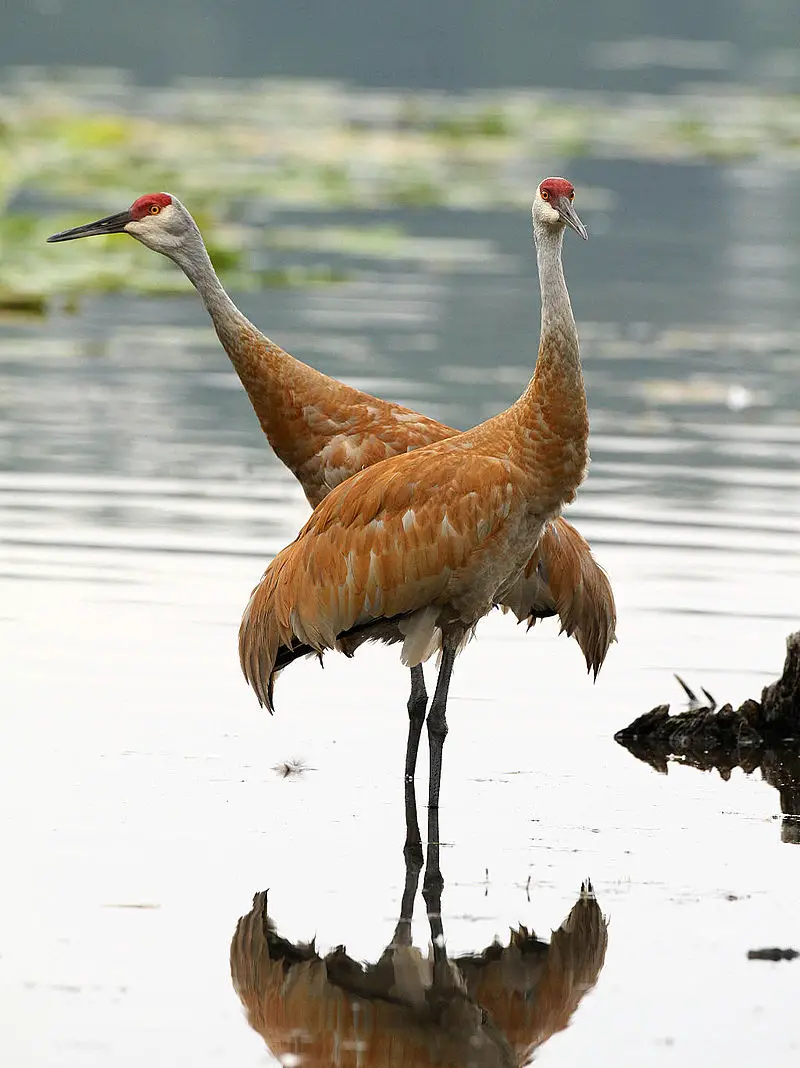
Cranes are majestic birds that can be found on most continents except Antarctica and South America. They are in the Gruiformes group of birds and belong to the family Gruidae.
Cranes have long legs and long necks and stand out from other birds due to their impressive size.
When they fly, they do so with their necks outstretched rather than pulled back like many other similar-looking species like herons.
There are fifteen species of cranes that are divided into three genera: Antigone, Balearica, and Grus.
They are a sight to behold and will leave a lasting impression on anyone lucky enough to observe them in their natural habitat.
Scientific classification:
| Kingdom | Animalia |
| Phylum | Chordata |
| Class | Aves |
| Order | Gruiformes |
| Superfamily | Gruoidea |
| Family | GruidaeVigors, 1825 |
Also Featured In: Most Common Birds in China, Flocks Birds around Us
2. Indian Peafowl
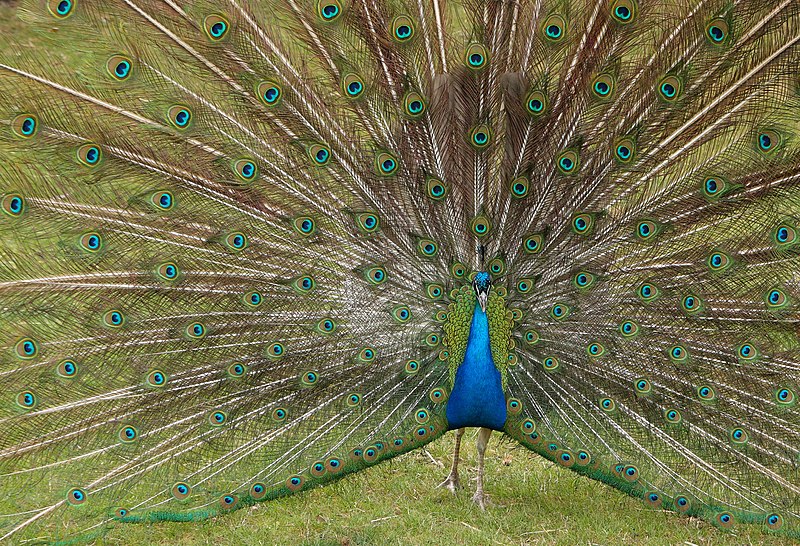
The Indian Peafowl, also known as the common peafowl or blue peafowl, is a species native to the Indian subcontinent. It has since been introduced to many other countries around the world.
Males are referred to as peacocks and females are called peahens, although both sexes can be colloquially referred to simply as “peacocks”.
These birds display sex-specific differences in colouration; males show off their iridescent feathers in shades of green and blues, while female plumage tends towards more muted browns with red accents on their tail feathers.
The mating dance performed by male Peacocks serves not only for courtship but also acts as a form of territorial advertisement between rival males over available resources such as food sources.
This colourful bird lives up to its name with its beautiful displays that captivate viewers from all walks of life.
Scientific classification:
| Kingdom | Animalia |
| Phylum | Chordata |
| Class | Aves |
| Order | Galliformes |
| Family | Phasianidae |
| Genus | Pavo |
| Species | P. cristatus |
Also Featured In: Common Birds in India, Blue Birds You’ll Found around Us
3. Northern Cardinal
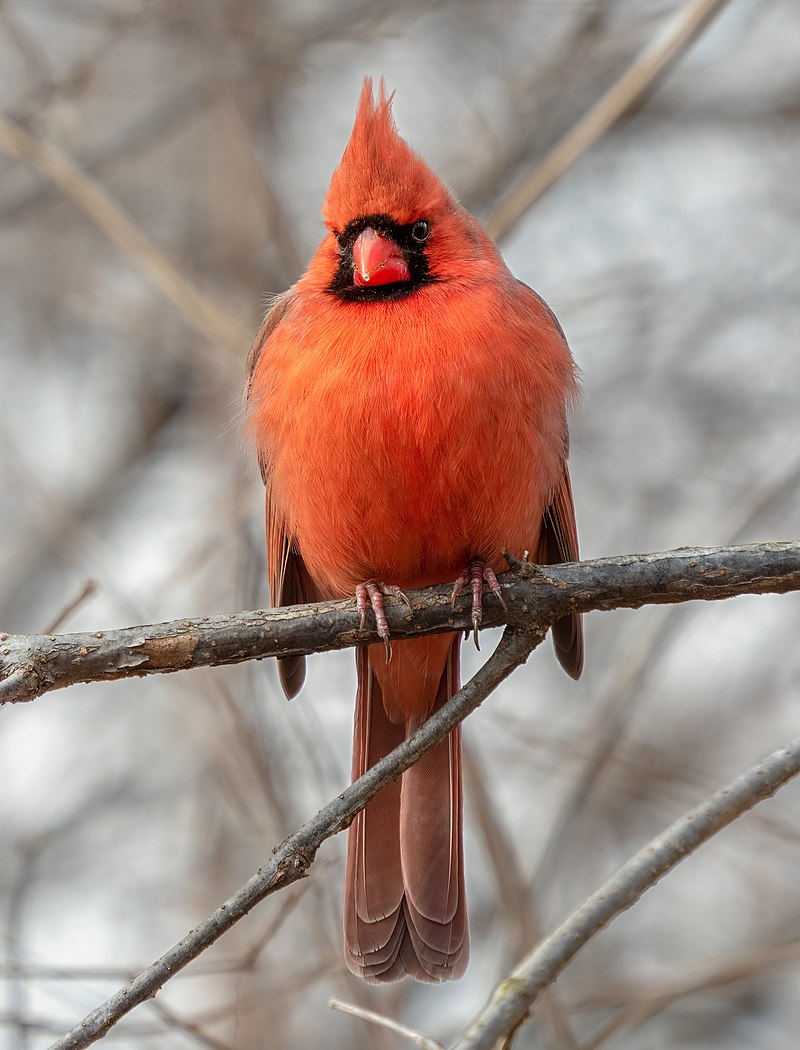
The Northern Cardinal is a beautiful bird, easily identified by its bright red plumage. It can be found in the eastern United States from Maine to Minnesota and south through Mexico and Belize.
Along with its striking colouration, it has a distinctive crest on its head and sharp black facial markings around the eyes.
Despite their small size (measuring 7-9 inches), they are very vocal birds – males sing persistently throughout springtime to attract mates or proclaim their territory.
They typically feed on insects, seeds and fruits but also enjoy suet at backyard bird feeders.
The female is less brightly coloured than her mate but still stands out among other songbirds due to her warm brownish-red feathers.
Cardinals pair for life, so you may often see them together in your garden or neighbourhood park.
Scientific classification:
| Kingdom | Animalia |
| Phylum | Chordata |
| Class | Aves |
| Order | Passeriformes |
| Family | Cardinalidae |
| Genus | Cardinalis |
| Species | C. cardinalis |
Also Featured In: Most Common United States Birds, Birds Commonly Found in New York
4. American Robin

The American robin is a migratory bird belonging to the true thrush genus and Turdidae family.
It was named after its European counterpart due to the similar reddish-orange breast they possess; however, they are not closely related.
This species can be seen through most of North America during winter months and in parts of Mexico and Central America, where it also breeds.
They have plump bodies with grey upper parts and white underparts that vary from yellow on their throats down to orange toward their bellies.
Robins feed on fruits such as berries or insects like worms, making them an important part of ecosystems by helping disperse seeds naturally throughout these areas.
Scientific classification:
| Kingdom | Animalia |
| Phylum | Chordata |
| Class | Aves |
| Order | Passeriformes |
| Family | Turdidae |
| Genus | Turdus |
| Species | T. migratorius |
Also Featured In: Birds That Live in Colorado, Birds Live in Arkansas
5. Bluebirds
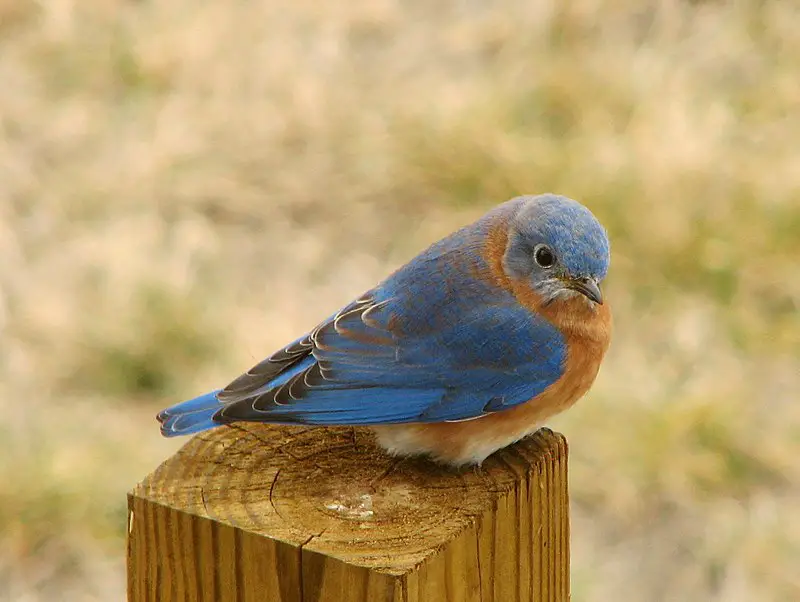
Bluebirds are a North American species of small to medium-sized birds belonging to the thrush family. They have stunning blue and rose beige plumage, with males having brighter colours than females.
These beautiful birds mainly feed on insects but can also eat some fruits or seeds occasionally. Bluebirds reside in open fields, meadows and backyards across much of North America.
Their cheerful songs bring joy as they fly through their habitats, looking for food during the day before returning home at nightfall.
Seeing these beautiful creatures is often associated with happiness and hope – making them beloved by many people.
Scientific classification:
| Kingdom | Animalia |
| Phylum | Chordata |
| Class | Aves |
| Order | Passeriformes |
| Family | Turdidae |
| Subfamily | Myadestinae |
| Genus | Sialia Swainson, 1827 |
Also Featured In: House Birds You’ll Love to Pet, Small Kentucky Birds
6. Blue Jay
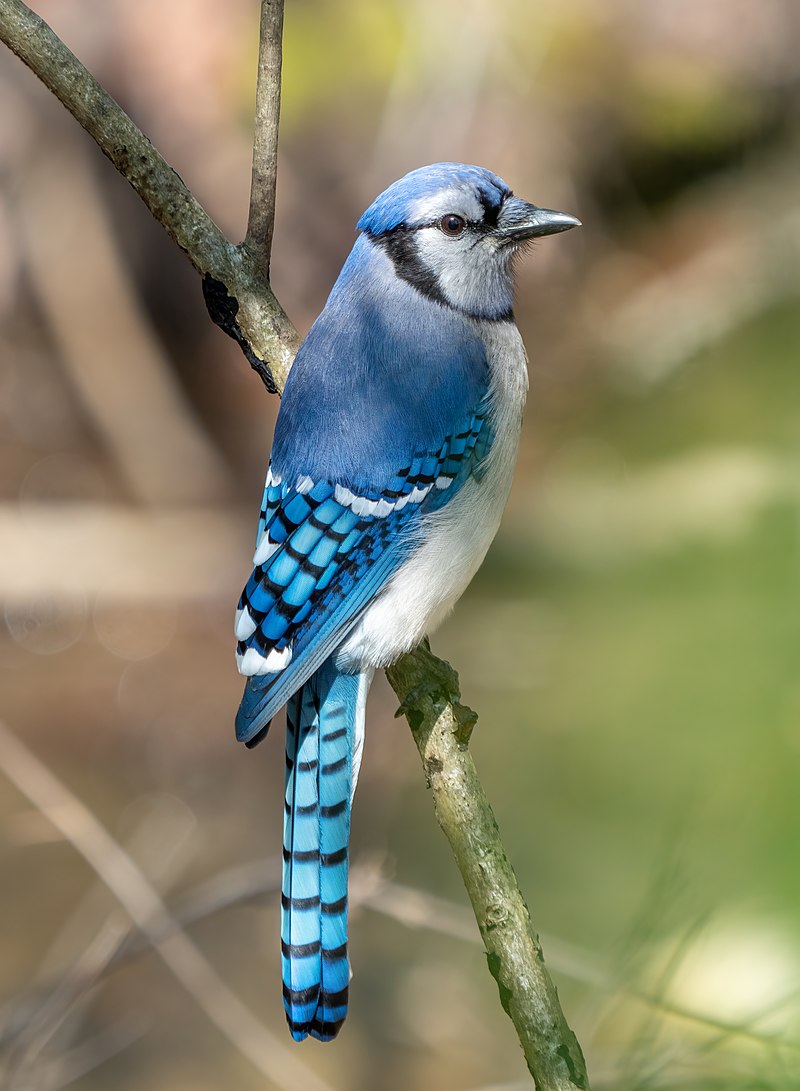
The Blue Jay is a beautiful bird residing in the eastern and central United States and Newfoundland, Canada. They have an unmistakable blue coloured plumage with white markings on their heads and wings.
These birds are highly adaptable to different habitats ranging from deciduous forests to urban areas.
As part of the Corvidae family, they are known for being intelligent problem solvers who will often use tools or mimic vocalizations of other species, like hawks, when defending their territories.
Their diet consists mostly of insects, seeds and nuts but can also include small vertebrates such as frogs or lizards if food resources become scarce.
Overall, these birds provide much-needed colour to our environment while playing important roles in maintaining healthy ecosystems through pollination services and seed dispersal activities.
Scientific classification:
| Kingdom | Animalia |
| Phylum | Chordata |
| Class | Aves |
| Order | Passeriformes |
| Family | Corvidae |
| Genus | Cyanocitta |
| Species | C. cristata |
Also Featured In: New Hampshire Birds You Should Know, Summer Birds that Live around Us
7. Bald Eagle
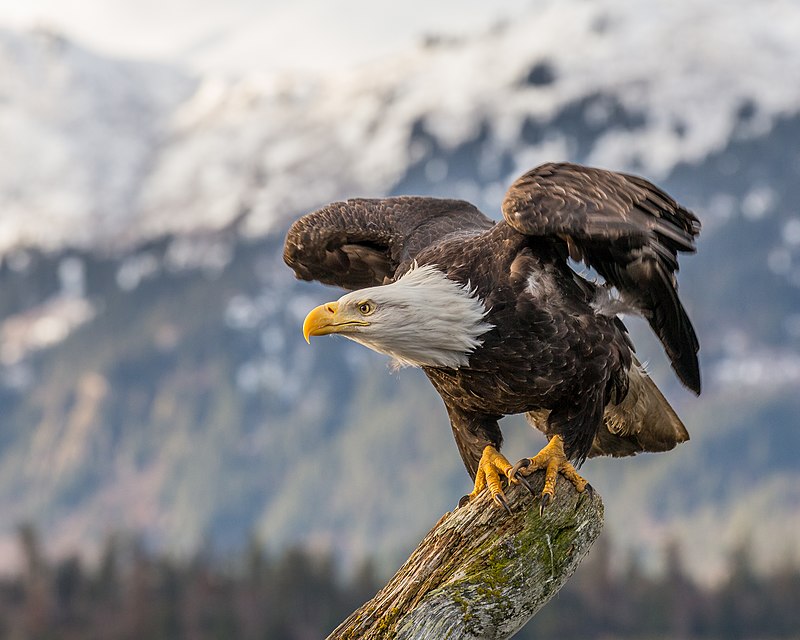
The majestic Bald Eagle is a bird of prey found in North America and recognized as the national symbol of the United States.
With its distinctive white head, brown body and striking yellow beak, this sea eagle has two known subspecies that form a species pair with the White-tailed Eagle.
It inhabits much of Canada, Alaska, all states in the US, contiguous areas, and Northern Mexico near large bodies of water where they feed mainly on fish.
These birds have an impressive wingspan ranging from 1.8 to 2 meters depending on their size, making them one of nature’s most magnificent creatures.
Scientific classification:
| Kingdom | Animalia |
| Phylum | Chordata |
| Class | Aves |
| Order | Accipitriformes |
| Family | Accipitridae |
| Genus | Haliaeetus |
| Species | H. leucocephalus |
Also Featured In: Everglades Birds, Birds that Found in the Yellowstone
8. House Sparrow
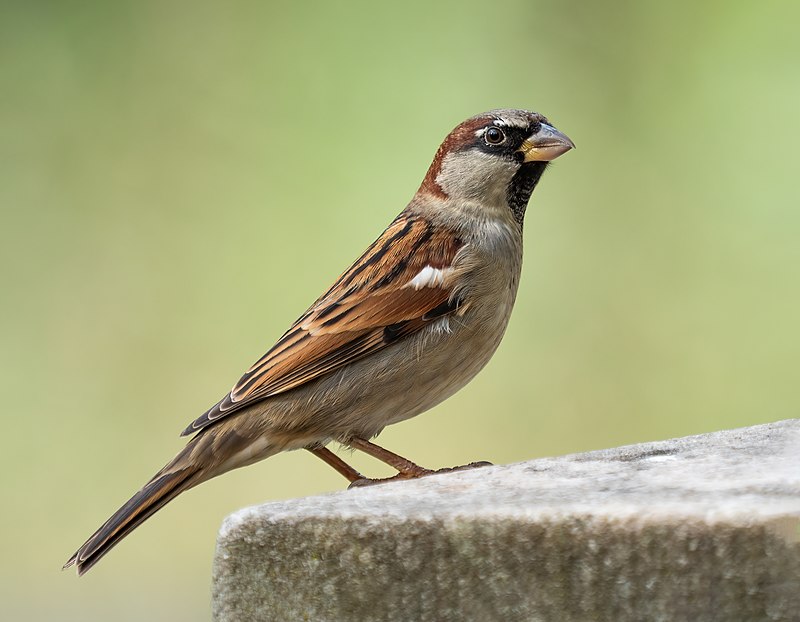
The house sparrow is a small bird of the Passeridae family. It has an average length of 16 cm and weighs 24-39.5 gm.
Females have dull brown and grey plumage, whereas males are brighter, with black, white and brown markings on their wings and back feathers.
This species is one among 25 different kinds in its genus Passer. These birds are found worldwide, mainly near human dwellings where they feed off food scraps from garbage bins or gardens, etc..
They also make nests close to houses, making them even more visible to nearby people.
House sparrows can be seen hopping around yards for food during daytime hours but usually hide in colonies at night.
Scientific classification:
| Kingdom | Animalia |
| Phylum | Chordata |
| Class | Aves |
| Order | Passeriformes |
| Family | Passeridae |
| Genus | Passer |
| Species | P. domesticus |
Also Featured In: Common Birds in the Cities, Asian Birds
9. Hummingbirds
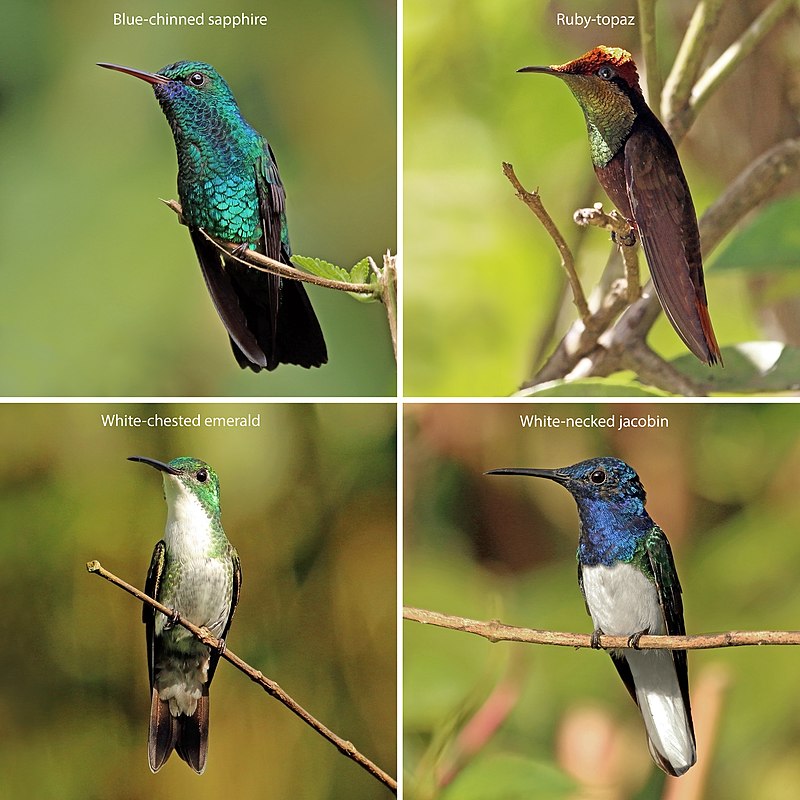
Hummingbirds are tiny birds found throughout the Americas, from Alaska to Tierra del Fuego. Most species measure between 3-5 inches in length and weigh less than an ounce.
The smallest hummingbird is only 2 inches long. Hummingbirds have a unique ability to hover by rapidly flapping their wings up to 80 times per second.
They feed on nectar and insects, with some species even able to drink sap or eat pollen directly off flowers.
Their vibrant colours make them instantly recognizable as they dart through gardens searching for food and mates.
Hummingbirds truly bring joy into our lives as they remind us that nature’s beauty can be seen around every corner if we take the time to look for it.
Scientific classification:
| Kingdom | Animalia |
| Phylum | Chordata |
| Class | Aves |
| Order | Apodiformes |
| Family | Trochilidae Vigors, 1825 |
Also Featured In: Birds that Live in the Deserts, Rainforest Birds You Should Know
10. Scarlet Macaw
The Scarlet Macaw is a vibrant and beautiful bird found in Central and South America. Its striking red, yellow, and blue feathers make it stand out among other parrots.
It inhabits humid evergreen forests of the Neotropics from Mexico to Peru, Ecuador, Colombia, Bolivia, Venezuela, and Brazil up to an altitude of 1000m (3300ft).
These birds have strong beaks, which they use to break open hard nuts or seeds that would otherwise remain inaccessible.
They also form social bonds with their mates by grooming each other’s feathers and engaging in playful activities such as chasing one another around tree trunks.
Despite its vivid colours, the Scarlet Macaw remains vulnerable due to habitat loss caused by deforestation, so conservation efforts are essential if this amazing species is going to survive for future generations.
Scientific classification:
| Kingdom | Animalia |
| Phylum | Chordata |
| Class | Aves |
| Order | Psittaciformes |
| Family | Psittacidae |
| Genus | Ara |
| Species | A. macao |
Also Featured In: Beautiful Brazilian Birds, Birds That Live in the Jungle
11. Scarlet Ibis
The Scarlet Ibis is a stunning bird native to tropical South America and the Caribbean. Its distinctive scarlet colouration stands out from other ibises in the Threskiornithidae family.
It has become one of two Trinidad and Tobago national birds with a Tupi-Guarani name: guará. This species can grow up to 28 inches long with an impressive wingspan of 39–41 inches wide.
The striking red feathers are found mainly on their body, while the wings, head and neck range from white to greyish.
They have black legs with pink webbed feet that help them thrive as they wade through shallow water searching for food such as shrimp, crabs and small fish – all essential components to their diet.
Despite its beauty, this species faces threats due to increasing habitat destruction caused by deforestation practices in areas where it lives, making conservation efforts crucial for protecting these majestic creatures before they disappear forever.
Scientific classification:
| Kingdom | Animalia |
| Phylum | Chordata |
| Class | Aves |
| Order | Pelecaniformes |
| Family | Threskiornithidae |
| Genus | Eudocimus |
| Species | E. ruber |
12. Cuckoos
Cuckoos are fascinating birds belonging to the Cuculidae family, which is the only taxon in the order Cuculiformes. This family has many different species, such as common or European cuckoos, roadrunners, koels, malkohas, couas, and anis.
Some of these species may even be identified as separate families – Centropodidae and Crotophagidae, respectively. These birds have been known for their unique features, such as loud calls heard consistently during certain times of day and night.
They also exhibit behaviour like brood parasitism, where they lay eggs in other nests so that their chicks can get more food from host parents than their own. All these traits make them one-of-a-kind creatures worth admiring.
Scientific classification:
| Kingdom | Animalia |
| Phylum | Chordata |
| Class | Aves |
| Clade | Otidimorphae |
| Order | Cuculiformes Wagler, 1830 |
| Family | Cuculidae Leach, 1820 |
Also Featured In: Most Common Types of Bangladeshi Birds, Birds of Sweden
13. Woodpeckers
Woodpeckers are an incredibly diverse bird species found worldwide except for Australia, New Guinea, New Zealand, Madagascar and the extreme polar regions.
They live in various habitats, including forests, woodlands, and rocky hillsides and deserts with no trees.
Their beaks are adapted to pecking at tree bark to find food, such as insects or larvae hidden beneath it, while they use their long tongues to catch them from deep inside crevices.
Woodpeckers have tough skulls that protect their brains from impact when they bang into things during drumming a behaviour used by males for territorial signalling and reproduction purposes which is done using strong rapid beats against hollow objects like dead branches or metal poles.
Scientific classification:
| Kingdom | Animalia |
| Phylum | Chordata |
| Class | Aves |
| Order | Piciformes |
| Infraorder | Picides |
| Family | Picidae Leach, 1820 |
Also Featured In: Common Serbian Birds, Most Common Nature Birds
14. Herons
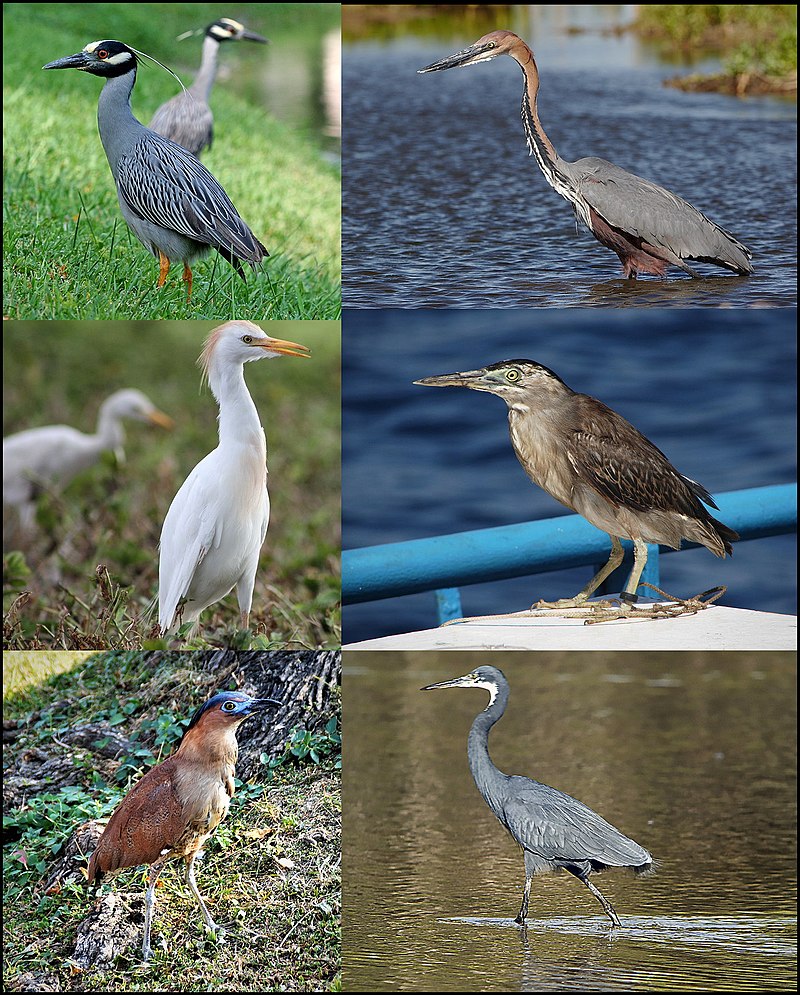
Herons are graceful and elegant birds belonging to the family Ardeidae, with 72 distinct species. They have long legs and necks that are well-adapted for wading in shallow water like streams or ponds.
Herons can be found near freshwaters as well as along coastal areas worldwide.
Some of these species may also be called egrets, bitterns or zigzag herons/bitterns because they belong to certain genera, such as Botaurus and Ixobrychus, respectively.
These birds stand tall when searching for food by standing still in a shallow body of water while waiting patiently until prey appears before quickly capturing it with their sharp bills.
Scientific classification:
| Kingdom | Animalia |
| Phylum | Chordata |
| Class | Aves |
| Order | Pelecaniformes |
| Suborder | Ardei |
| Family | Ardeidae Leach, 1820 |
Also Featured In: Birds You’ll Find in Moldova, Most Common Lake Birds
15. Grey Heron
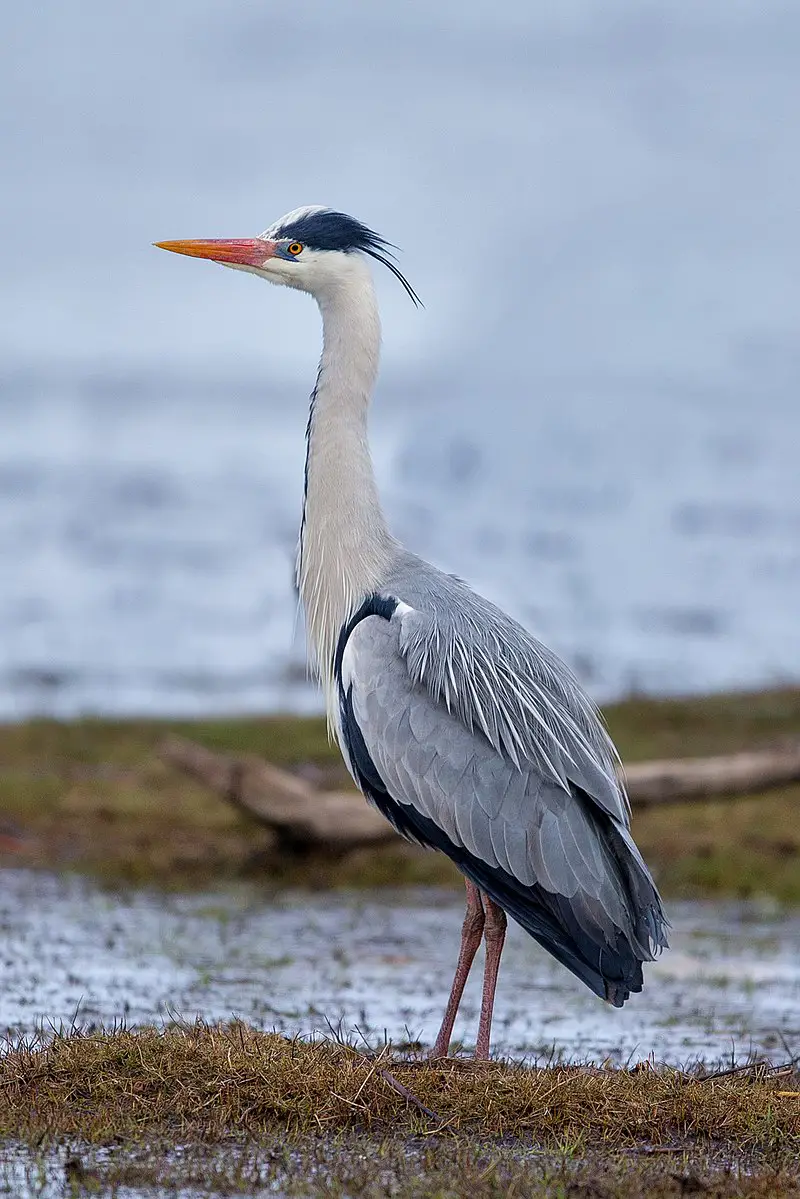
The grey heron is a majestic bird found in temperate regions of Europe, Asia and parts of Africa. It has long legs to wade through the shallow waters where it feeds on aquatic creatures such as frogs, fish and insects.
In wintertime, some migrate southwards, but others stay put in their natural habitats: lakes, rivers and marshes. They can also be spotted near coasts or along estuaries.
Grey Herons have beautiful blue-grey feathers and an impressive wingspan, making them stand out from other birds when they soar gracefully across the sky. These graceful creatures are easy on the eye and wise hunters too.
Scientific classification:
| Kingdom | Animalia |
| Phylum | Chordata |
| Class | Aves |
| Order | Pelecaniformes |
| Family | Ardeidae |
| Genus | Ardea |
| Species | A. cinerea |
Also Featured In: Common Birds in Japan, Most Common Romanian Birds
16. Crow Family
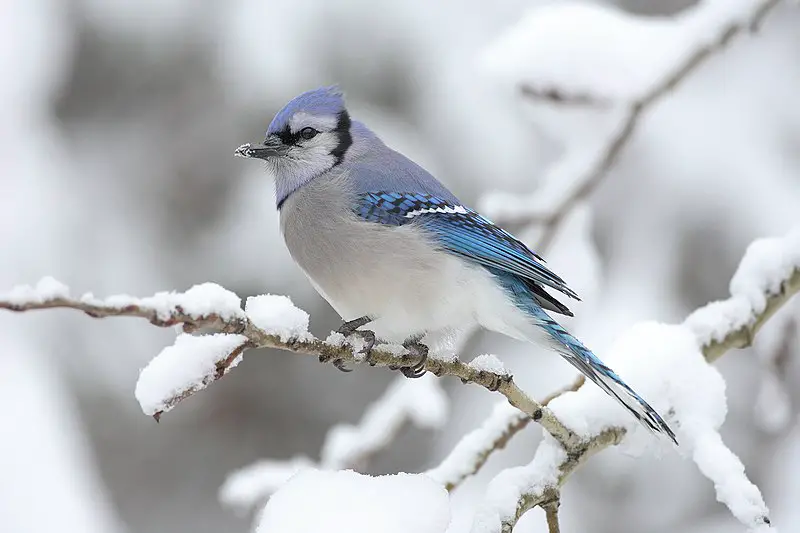
The Crow family is a cosmopolitan group of birds that contains crows, ravens, rooks, jackdaws, jays, magpies and more.
Altogether, there are 133 members in this bird family, which all share similar characteristics such as large beaks and feet.
The genus Corvus alone makes up over a third of the entire crow family population, with species like the common crow or blackbird being some of its most recognizable members.
All these birds have strong social bonds, so they often travel in groups to find food sources or build nests together for protection against predators.
With their intelligence and adaptation skills, they can survive almost anywhere on Earth, from mountains to cities, making them one of the world’s most successful families of avian creatures.
Scientific classification:
| Kingdom | Animalia |
| Phylum | Chordata |
| Class | Aves |
| Order | Passeriformes |
| Superfamily | Corvoidea |
| Family | Corvidae Leach, 1820 |
Also Featured In: Turkey Birds You Should Know, Common Denmark Birds
17. Falcon
Falcons are majestic birds of prey found in almost all parts of the world except Antarctica. They have long, slender wings that allow them to fly swiftly and change directions quickly.
As adults, they feed on small animals such as mice and insects, but when young, their diet consists mainly of carrion or food provided by their parents.
Falcons use a range of techniques for hunting, including hovering high up above potential prey before diving down at great speed to catch it during flight.
They also ambush unsuspecting victims from concealed perches close to the ground.
These remarkable hunters can even take advantage of thermal currents rising off warm surfaces like roads, giving them an extra boost while flying.
Scientific classification:
| Kingdom | Animalia |
| Phylum | Chordata |
| Class | Aves |
| Order | Falconiformes |
| Family | Falconidae |
| Subfamily | Falconinae |
| Genus | Falco Linnaeus, 1758 |
Also Featured In: Egyptian Birds, Common Carnivore Birds
18. Great Tit
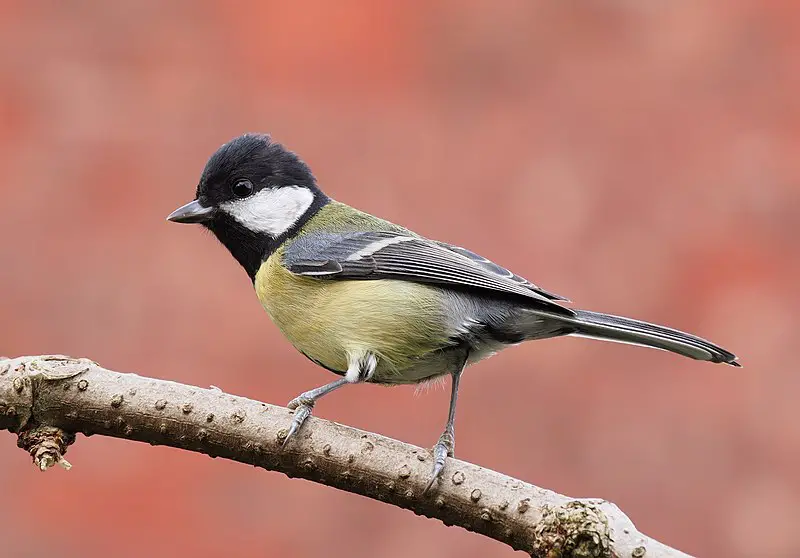
The Great Tit is a small passerine bird found in woodlands throughout Europe, the Middle East and Central Asia. Its beautiful black and white plumage with bold yellow or green patches make it easily distinguishable from other species of its family.
It generally does not migrate except for harsh winters but will stay resident in any woodland area.
The diet consists mainly of insects, seeds and nuts, which are found by searching through trees or scavenging from feeders placed near gardens.
Great Tits are also known to be clever problem solvers; they can open milk bottles left out unattended as well as cracking sunflower seeds that provide them essential nutrients during winter months when food is scarce.
Scientific classification:
| Kingdom | Animalia |
| Phylum | Chordata |
| Class | Aves |
| Order | Passeriformes |
| Family | Paridae |
| Genus | Parus |
| Species | P. major |
Also Featured In: Birds of United Kingdom, Birds Found in Hungary
19. Carrion Crow
The Carrion Crow is a large, black bird belonging to the Corvidae family and genus Corvus. Native to Western Europe and Eastern Palearctic, it was one of the species described by Carl Linnaeus in his 1758 10th edition of Systema Naturae.
The name comes from Latin words meaning “crow” and “crown”. This crow has an unmistakable appearance; its entire body is covered in glossy black feathers with blue or purple iridescence on its wings when caught in sunlight.
Its diet consists mainly of carrion, but they also eat insects, fruits, grains, nuts, eggs and small vertebrates such as young birds.
They are known for their intelligence, which allows them to find food more easily than other corvid species due to their ability to make tools out of sticks or stones like humans do.
Scientific classification:
| Kingdom | Animalia |
| Phylum | Chordata |
| Class | Aves |
| Order | Passeriformes |
| Family | Corvidae |
| Genus | Corvus |
| Species | C. corone |
20. Swallows
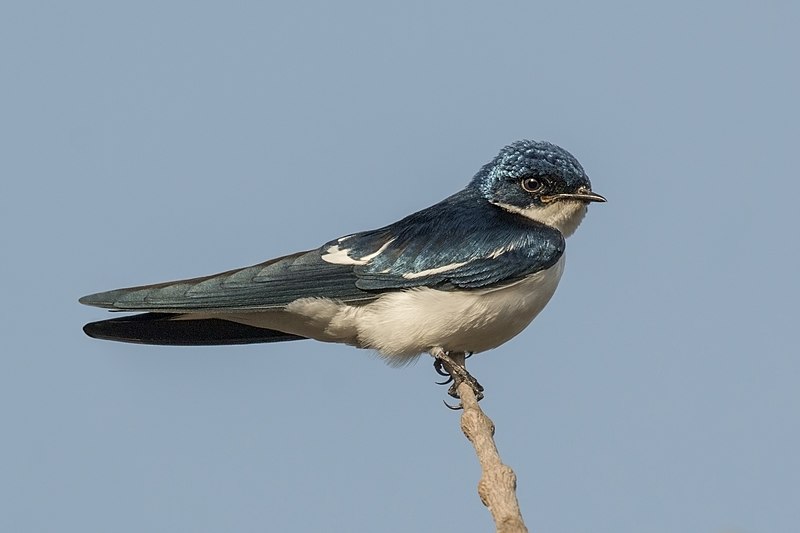
Swallows are small songbirds found worldwide on all continents, even Antarctica. They have a distinctive appearance and are highly adapted to aerial feeding with their long wings and forked tails.
There are an estimated 90 species of swallows in 19 different genera, making them one of the most widespread bird families on earth.
The barn swallow is perhaps the most well-known species among these birds due to its presence near human settlements across Europe; they’re so ubiquitous that “swallow” has become synonymous with this particular type of bird there.
Swallows also play important roles in ecology as insectivores, some species migrating vast distances yearly between summer breeding grounds and wintering locations.
Scientific classification:
| Kingdom | Animalia |
| Phylum | Chordata |
| Class | Aves |
| Order | Passeriformes |
| Suborder | Passeri |
| Family | Hirundinidae Rafinesque, 1815 |
Also Featured In: Birds that are Used in Feng Shui, Common Species of Birds
21. Common Buzzard
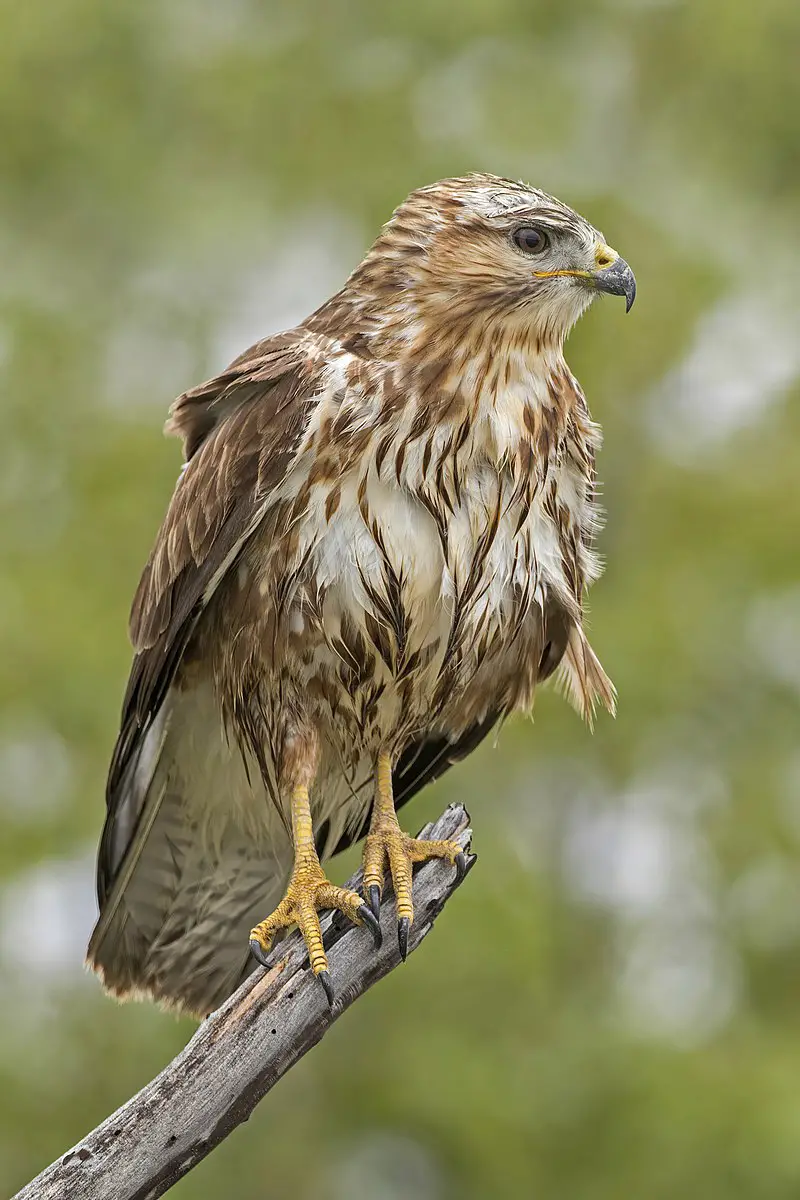
The common buzzard is a large bird of prey found across much of Europe, the Palearctic region and parts of Asia. This species has medium to dark brown plumage with lighter streaks on its body.
It has broad wings, which are useful for soaring high in search of food, such as small rodents, lizards, amphibians and insects.
Buzzards often hunt from a perch or while hovering above open areas like fields and meadows where they can easily spot their prey below.
They also use thermals rising from warm ground during hot summer days to gain altitude without expending energy flapping their wings.
In addition to hunting alone, these birds will sometimes join forces with others when scavenging carrion or chasing away predators that threaten their nests full of eggs or young chicks.
Scientific classification:
| Kingdom | Animalia |
| Phylum | Chordata |
| Class | Aves |
| Order | Accipitriformes |
| Family | Accipitridae |
| Genus | Buteo |
| Species | B. buteo |
Also Featured In: European Birds, Most Common Scotland Birds
22. Great Egret
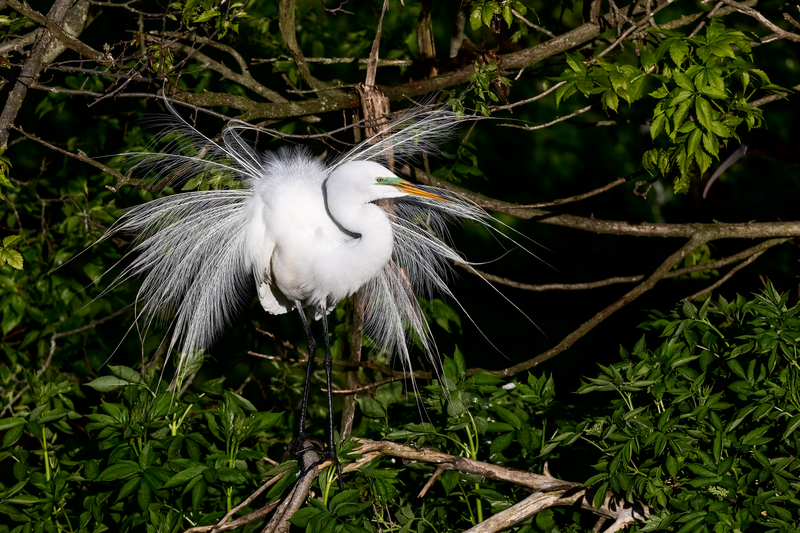
The Great Egret is a large, white bird found in many regions of the world. It has four subspecies that reside across Asia, Africa, the Americas and southern Europe.
This species usually lives near bodies of water such as lakes and marshes. They are also now starting to spread into more northern areas of Europe due to climate change.
These birds have long yellow legs with an impressive wingspan, allowing them to soar majestically through the sky, hunting for fish or amphibians in shallow waters below.
Their feathers have been used historically by Native Americans as part of traditional garments or ceremonies, but this practice should be avoided today so these amazing creatures can thrive without harm from humans.
Scientific classification:
| Kingdom | Animalia |
| Phylum | Chordata |
| Class | Aves |
| Order | Pelecaniformes |
| Family | Ardeidae |
| Genus | Ardea |
| Species | A. alba |
Also Featured In: Most common Birds in France, Swamps Birds You Should Know
23. Stork
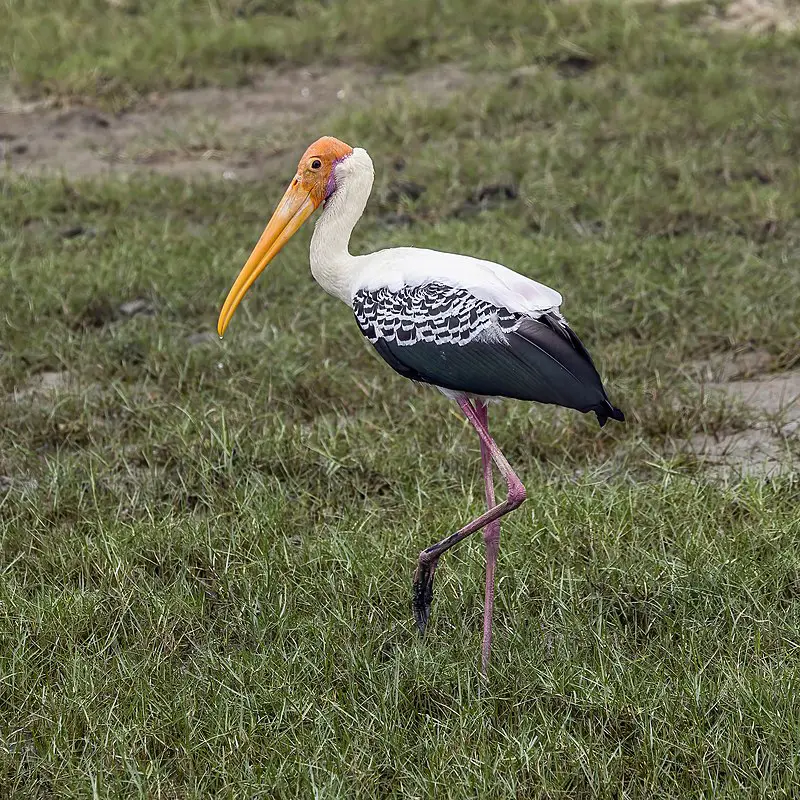
Storks are majestic birds, easily recognizable by their long necks and legs. They belong to the family Ciconiidae, making up the order Ciconiiformes.
Storks inhabit many areas worldwide but generally prefer drier habitats than other wading birds like herons or ibises, which have been moved to separate orders.
Despite being large in size, they can be quite graceful in flight and when hunting for food, such as insects, small mammals and reptiles near shallow waters.
During nesting season, stork pairs build nests on high trees or platforms made of sticks and twigs where they lay eggs that hatch after about a month of incubation by both parents sitting on them warmly until hatching day.
Scientific classification:
| Kingdom | Animalia |
| Phylum | Chordata |
| Class | Aves |
| Clade | Aequornithes |
| Order | Ciconiiformes Bonaparte, 1854[1] |
| Family | Ciconiidae J. E. Gray, 1840[1] |
Also Featured In: Native South Korean Birds, Bulgarian Birds
24. Common Raven
The Common Raven is an iconic black bird found throughout the Northern Hemisphere. It belongs to the Corvus corax species of passerines and has at least eight subspecies with little physical variation between them.
Recent research, however, suggests there are significant genetic differences among populations from various areas.
They have a large wingspan of up to 1m, and their call can be heard over great distances due to their deep croaking sound; they also use mimicry for communication purposes as many other birds do.
The raven’s diet consists mostly of carrion, insects and fruits, but they will also scavenge in human settlements when food sources become scarce.
Their nests require plenty of space, so these birds prefer open habitats such as tundra or mountain regions- ideal conditions for their long-distance migrations.
Scientific classification:
| Kingdom | Animalia |
| Phylum | Chordata |
| Class | Aves |
| Order | Passeriformes |
| Family | Corvidae |
| Genus | Corvus |
| Species | C. corax |
Also Featured In: Birds of Poland, Birds that Live in San Francisco Bay Area
25. Cardinal
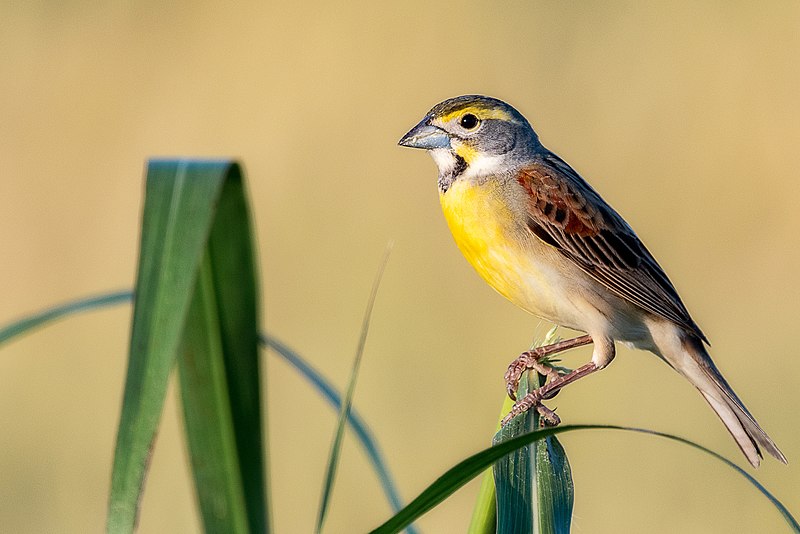
Cardinalidae is a family of passerine birds endemic to the New World, including cardinals, grosbeaks and buntings.
This large group has great diversity in its members, ranging from tanager-like Piranga to warbler-like Granatellus.
They are usually distinguished by their bright plumage, with reds, oranges and yellows being common among them.
Their strong bills enable them to feed on seeds, fruits, insects, and other small prey items like lizards or frogs, depending upon species.
Cardinals also have loud calls often used for territorial defence and courtship purposes, while some can even imitate sounds made by other animals.
These adaptable birds inhabit various habitats across North America, making them an important part of many ecosystems there.
Scientific classification:
| Kingdom | Animalia |
| Phylum | Chordata |
| Class | Aves |
| Order | Passeriformes |
| Superfamily | Emberizoidea |
| Family | Cardinalidae Ridgway, 1901 |
Also Featured In: Common Birds in Canada, Birds that Migrate through Illinois in the Spring
26. Pine Grosbeak
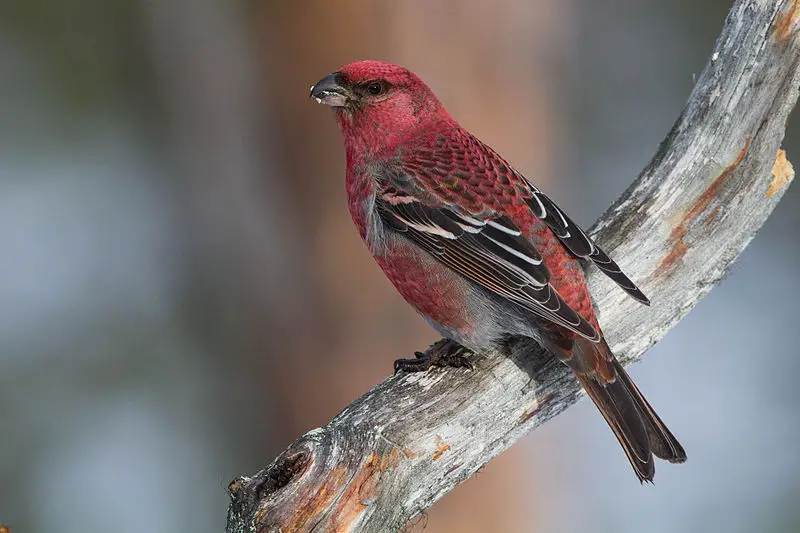
Pine grosbeak is a beautiful bird found across Alaska, the western US, Canada, Fennoscandia, and Siberia. It belongs to the family of true finch and is the only species in its genus Pinicola.
This frugivorous bird has bright red feathers on its head and wings with yellowish-white underparts that make it very attractive.
During the winter, they feed mostly on small fruits like rowans, blueberries, etc., while during the summer, their diet consists mainly of insects.
They are shy birds but can be seen perched at high branches or singing from the topmost trees if you look carefully enough.
Scientific classification:
| Kingdom | Animalia |
| Phylum | Chordata |
| Class | Aves |
| Order | Passeriformes |
| Family | Fringillidae |
| Subfamily | Carduelinae |
| Genus | Pinicola Vieillot, 1808 |
| Species | P. enucleator |
Also Featured In: Common Birds in Saskatchewan, Common Birds in Alberta
27. Crows
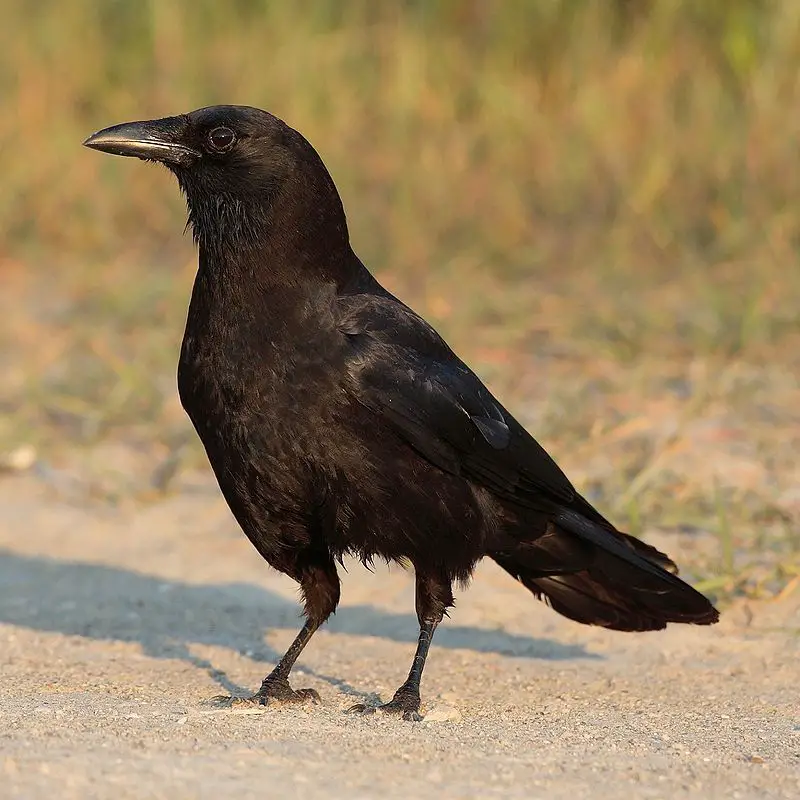
Crows are medium to large birds with a wide range of species belonging to the Corvidae family. They can be found in Europe, Asia, America and Australia.
Common crows include carrion crow, hooded crow, common raven and rooks, which differ mainly by size; crows are generally smaller than their counterparts.
Crows have distinctive black feathers that contrast against their white eyes, and they possess an intelligence far beyond other birds as they will use tools for tasks like cracking open nuts or making nests out of twigs.
Their curious nature makes them great problem-solvers when faced with challenging situations such as finding food sources or navigating new terrain.
Scientific classification:
| Kingdom | Animalia |
| Phylum | Chordata |
| Class | Aves |
| Order | Passeriformes |
| Family | Corvidae |
| Subfamily | Corvinae |
| Genus | Corvus Linnaeus, 1758 |
Also Featured In: Birds of Netherlands,
28. Albatrosses
Albatrosses are majestic, large seabirds belonging to the Diomedeidae family in the Procellariiformes order.
These birds have impressive wingspan and can fly far over oceans with minimal effort.
They inhabit all of the world’s southern oceans, ranging from Antarctica to New Zealand and Australia and parts of the northern Pacific Ocean region.
Albatross populations were once abundant throughout much of their range, but they now face threats such as longline fishing gear entanglement, which has caused a significant decline in numbers in some areas.
Furthermore, occasional vagrants have been found outside their native ranges including fossil remains suggesting that albatrosses previously existed on other regions too.
Scientific classification:
| Kingdom | Animalia |
| Phylum | Chordata |
| Class | Aves |
| Order | Procellariiformes |
| Family | Diomedeidae G.R. Gray 1840[1] |
Also Featured In: New Zealand Birds, Birds You’ll Find in the Sea
29. Scarlet Flycatcher
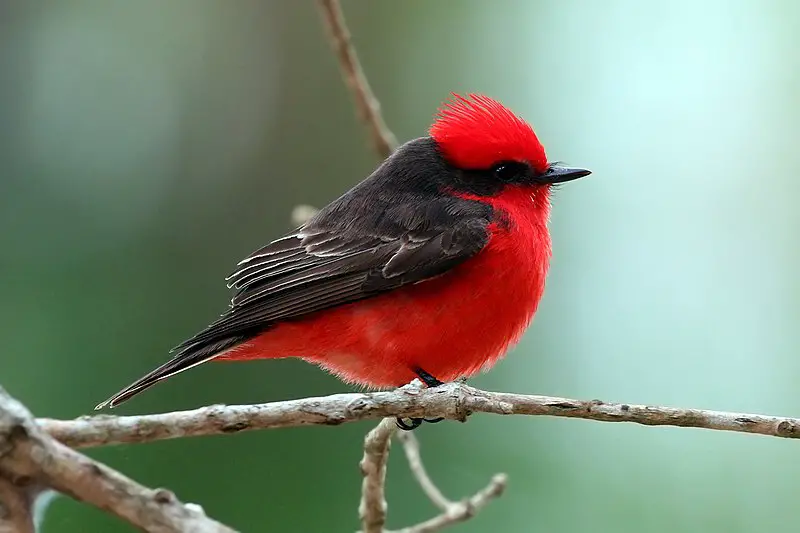
The Scarlet Flycatcher, or the Austrial Vermilion Flycatcher, is an eye-catching bird in southeastern Bolivia, Brazil, Paraguay Argentina and Uruguay.
It belongs to a group of flycatchers closely related to the vermilion flycatcher. This species has bright orange feathers on its face and chest combined with black wings, making it unmistakable when seen up close.
Its diet consists of insects which they catch while flying low over open terrain like creeks or marshes using their agile flight capabilities.
While some taxonomic authorities recognize this bird as a separate species from the Vermillion Flycatcher, others still consider it simply a subspecies thereof.
Overall, they are very beautiful birds that will add beauty wherever they are spotted.
Scientific classification:
| Kingdom | Animalia |
| Phylum | Chordata |
| Class | Aves |
| Order | Passeriformes |
| Family | Tyrannidae |
| Genus | Pyrocephalus |
| Species | P. rubinus |
Also Featured In: Flycatchers Species, Red birds You’ll See in Arizona
30. Old World Sparrows
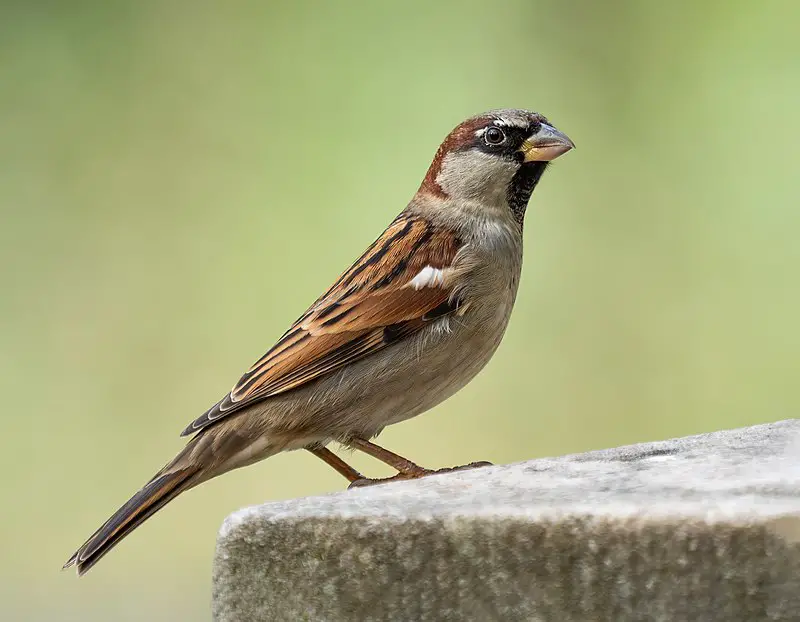
Old World sparrows are small passerine birds belonging to the family Passeridae. They are characteristically much smaller than their New World counterparts, ranging in size from 6 centimetres up to 20 centimetres, depending on the species.
The most common characteristics of these birds include a black or grey head and upper body with white underparts and white stripes above their eyes.
Notable features such as barring and streaking can be found across different species within this group.
Old-world sparrows typically inhabit open grassland areas but have been known to nest around human dwellings near urban settings as well, making them easily recognizable by many people all over the globe.
Scientific classification:
| Kingdom | Animalia |
| Phylum | Chordata |
| Class | Aves |
| Order | Passeriformes |
| Suborder | Passeri |
| Infraorder | Passerida |
| Superfamily | Passeroidea |
| Family | Passeridae Rafinesque, 1815 |
Also Featured In: Alaska Birds, Most Common Winter Birds
31. Summer Tanager
The Summer Tanager is a stunningly beautiful member of the cardinal family. Native to North and South America, this medium-sized songbird features striking red plumage on its back with yellow underparts.
It has a pointed black bill and long tail feathers that can be seen fluttering through the air when it flies.
The species’ vocalizations are quite similar to those of other members of its genus as well, which often include short whistles and chirps in addition to longer songs made up of various phrases or syllables.
With their vibrant colours and melodic voices, these birds make an eye-catching sight any time they appear.
Scientific classification:
| Kingdom | Animalia |
| Phylum | Chordata |
| Class | Aves |
| Order | Passeriformes |
| Family | Cardinalidae |
| Genus | Piranga |
| Species | P. rubra |
Also Featured In: birds of Arkansas, Most Common Songs Birds that Live around You
32. Crimson Sunbird
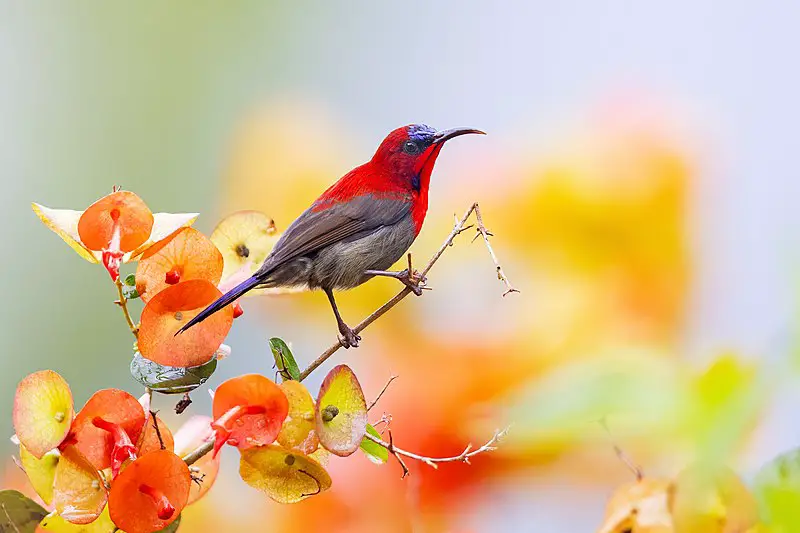
The Crimson sunbird is a species of bird that belongs to the Sunbird family. They have short wings and are known for their fast and direct flight.
These birds primarily feed on nectar but may also take insects, especially when feeding young ones. Their method of feeding includes hovering like hummingbirds or perching on branches.
The Nature Society Singapore has unofficially announced it as the national bird due to its vibrant colours, which add beauty to our nation’s landscape.
It is an important part of nature with its unique characteristics, making them very special in every way possible.
Scientific classification:
| Kingdom | Animalia |
| Phylum | Chordata |
| Class | Aves |
| Order | Passeriformes |
| Family | Nectariniidae |
| Genus | Aethopyga |
| Species | A. siparaja |
Also Featured In: Red Birds, Pet Birds that Live in India
33. Swans
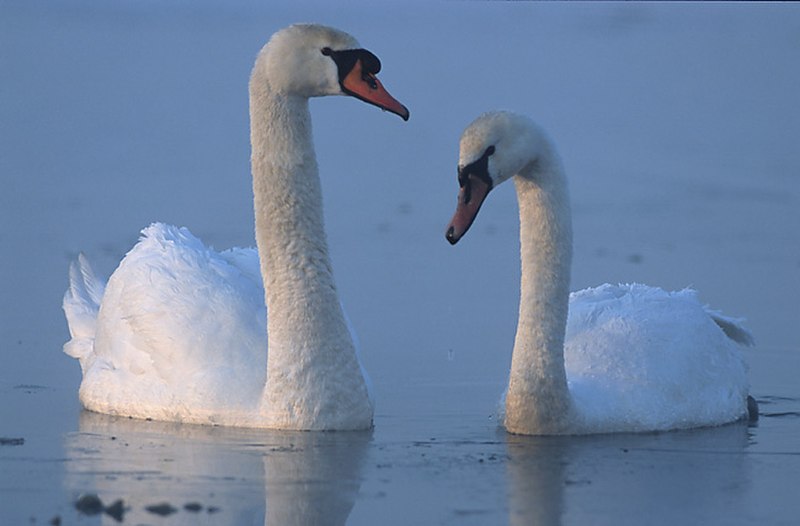
Swans are graceful and elegant birds belonging to the family Anatidae. They have a long neck, black beak and large wings that give them their majestic look.
Their closest relatives include geese and ducks, who belong to the same subfamily Anserinae as swans do.
Six living species of swan are found in different parts of the world – Mute Swan, Black-necked Swan, Tundra Swan, Whooper Swan, Trumpeter Swan and Coscoroba Swam.
These beautiful creatures usually live on lakes or rivers but can also inhabit wetlands such as marshes or estuaries for nesting purposes.
Despite being very social animals with strong pair bonds, they remain solitary during migration periods when they travel long distances looking for better feeding grounds.
Scientific classification:
| Kingdom | Animalia |
| Phylum | Chordata |
| Class | Aves |
| Order | Anseriformes |
| Family | Anatidae |
| Subfamily | Anserinae |
| Genus | Cygnus Garsault, 1764 |
Also Featured In: birds of white, Water Birds Live around Us
34. Columbidae
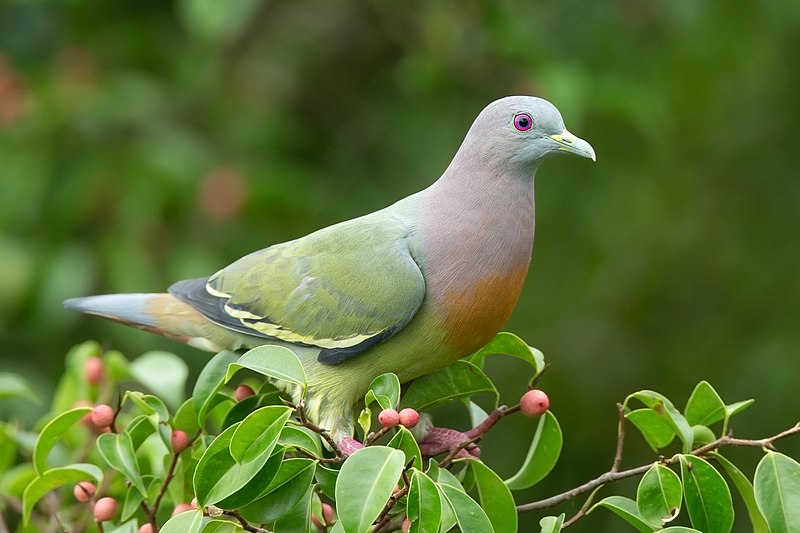
Columbidae is a bird family that includes both doves and pigeons. These birds are characterized by their stout bodies, short necks, and small, slender bills with fleshy ceres in some species.
They feed mainly on seeds, fruits, and plants found worldwide but have the greatest variety in the Indomalayan and Australasian regions.
Columbidae have an unmistakable soft cooing sound, making them one of the most beloved avian families worldwide – especially among city dwellers.
Whether it be feeding time or just hearing their soothing call throughout nature walks, these birds will remain favourites for many years.
Scientific classification:
| Kingdom | Animalia |
| Phylum | Chordata |
| Class | Aves |
| Clade | Columbimorphae |
| Order | Columbiformes Latham, 1790 |
| Family | Columbidae Leach, 1820 |
Also Featured In: Birds for Your Home Garden, Flight Birds You Should Know
35. Common Nightingale
The Common nightingale, also called the rufous nightingale, is a small bird known for its beautiful and powerful song. It was formerly considered a thrush but is now classified as an Old World flycatcher.
The bird is a member of the Muscicapidae family and is often referred to as a chat due to its terrestrial behaviour.
The nightingale’s song is widely appreciated for its melodious and varied notes. The bird’s plumage is brown, with a hint of a reddish colour, and it has a stout beak for feeding on insects.
The Common nightingale can be found throughout Europe, Western Asia, and parts of Africa. Overall, the bird is known for its vibrant and distinctive singing voice.
Scientific classification:
| Kingdom | Animalia |
| Phylum | Chordata |
| Class | Aves |
| Order | Passeriformes |
| Family | Muscicapidae |
| Genus | Luscinia |
| Species | L. megarhynchos |
Also Featured In: Birds of Symbolism, Birds You’ll Find in Night
36. European Robin
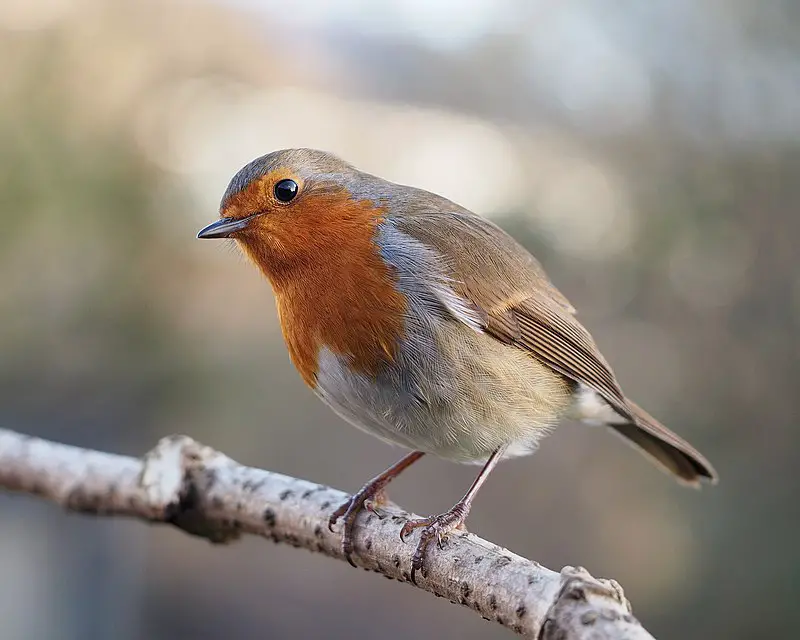
The European robin, also known as simply robin or robin redbreast, is a small insect-eating bird belonging to the chat subfamily.
This bird species can be found across Europe, extending east to Western Siberia while inhabiting North Africa.
The bird species is relatively sedentary and is found in most of its range, except for the far north.
Measuring around 12.5-14.0 cm, this bird is commonly known for its distinctively red breast feathers.
As an insectivorous passerine bird, the European robin mainly feeds on insects to sustain its energy.
Given its widespread range throughout Europe and continuous presence in certain parts of the world, the European robin is widely recognized for its distinct physical appearance, singsong voice, and tiny size.Scientific classification:
| Kingdom | Animalia |
| Phylum | Chordata |
| Class | Aves |
| Order | Passeriformes |
| Family | Muscicapidae |
| Genus | Erithacus |
| Species | E. rubecula |
Also Featured In: Italian Birds You Should Know, Ukrainian Birds You Should Know
37. Owls
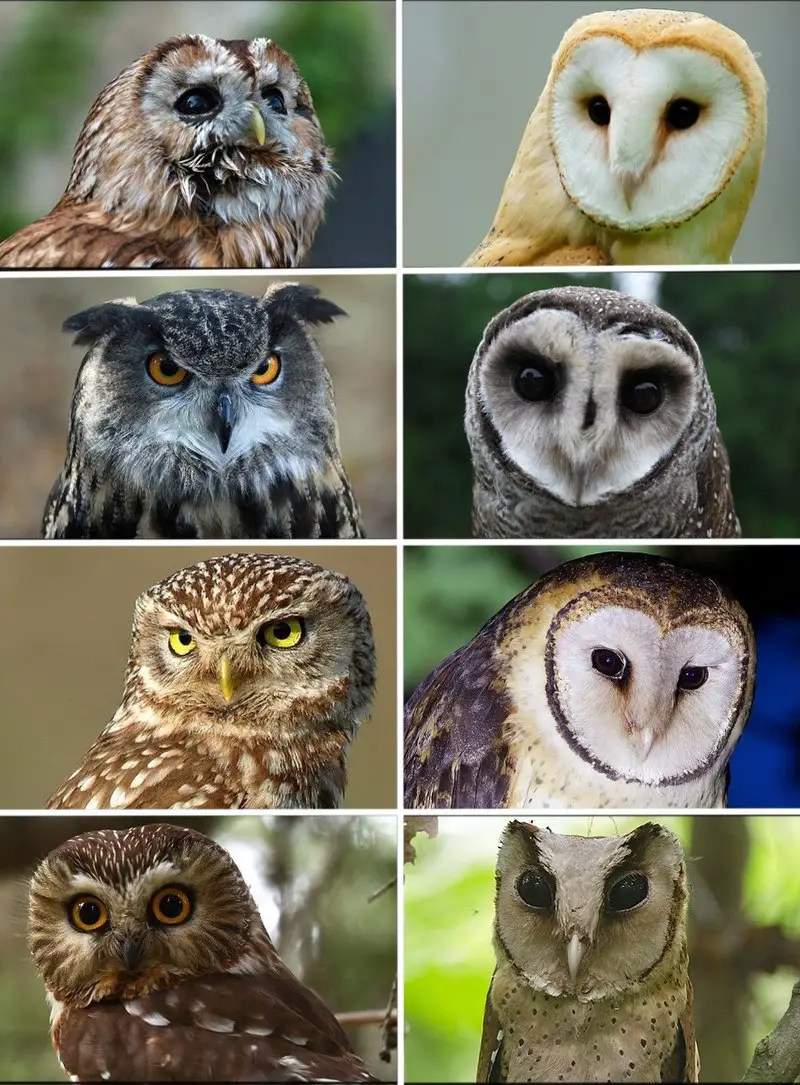
Owls are remarkable birds of prey that belong to the order Strigiformes. Known for their solitary and nocturnal behaviour, these birds are commonly associated with an upright stance, broad head, binocular vision, binaural hearing, sharp talons, and specially adapted feathers for silent flight.
With over 200 species, owls are mostly carnivorous and hunt small mammals, making them excellent at controlling rodent populations.
Although most owls are solitary animals, some species, such as the gregarious burrowing owl, are social and interact regularly with their own kind.
Despite their nocturnal habits, some owls, like the northern hawk owl, are diurnal and hunt during daylight hours.
All in all, owls are fascinating creatures that have intrigued bird watchers and scientists alike for many years.
Scientific classification:
| Kingdom | Animalia |
| Phylum | Chordata |
| Class | Aves |
| Clade | Telluraves |
| Order | Strigiformes Wagler, 1830 |
Also Featured In: Famous Paintings Birds, Birds You’ll Find in Zoo
38. Crimson Finch
The Crimson Finch is a bold and striking bird belonging to the Estrildidae family. It can be found all throughout northern Australia and parts of southern New Guinea.
This bird is easily identifiable by its radiant crimson feathers, making it a popular bird among birdwatchers. Despite its good looks, the Crimson Finch is known to be quite aggressive.
This makes it an interesting bird to observe and one that should be cautiously approached. The Crimson Finch was first observed by Hombron and Jacquinot at Raffles Bay in northern Australia in 1841.
Its protonym is Fringilla phaeton. The Crimson Finch is a beautiful and fascinating bird that brightens up the Australian skies with its vivid plumage.
Scientific classification:
| Kingdom | Animalia |
| Phylum | Chordata |
| Class | Aves |
| Order | Passeriformes |
| Family | Estrildidae |
| Genus | Neochmia |
| Species | N. phaeton |
Also Featured In: Birds that Charles Darwin Studied,
39. Cape Crow
The Cape crow, also known as the black crow, is a bird species that measures around 48-50 cm in length. It is completely black with a subtle purple gloss in its feathers, giving it a regal appearance.
The Cape crow has longer legs, wings, and tail compared to other crow species, and its bill is considerably longer and slimmer, developed to probe the ground for invertebrates. The head feathers of the Cape crow have a coppery-purple gloss.
These birds are known for their intelligence and ability to adapt to new environments. They are commonly found in South Africa, particularly in urban areas where their adaptability has helped them thrive.
The Cape crow is a striking species with unique physical characteristics and remarkable adaptability.
Scientific classification:
| Kingdom | Animalia |
| Phylum | Chordata |
| Class | Aves |
| Order | Passeriformes |
| Family | Corvidae |
| Genus | Corvus |
| Species | C. capensis |
Also Featured In: Scavengers Birds You Should Know, Birds of Etosha National Park
Conclusion
Birds have long been revered as symbols of deeper meaning and spiritual significance in various cultures and spiritual traditions.
These 39 spiritual birds each carry unique symbolism and messages, reflecting aspects of the human experience and the connection between the material and spiritual realms.
From the soaring eagle symbolizing freedom and vision to the mystical owl representing inner wisdom, these avian beings serve as messengers, guides, and sources of inspiration.
The diversity of these spiritual birds underscores the universal human fascination with nature and the profound ways in which we seek to understand our place in the world through the symbolism of these winged creatures.